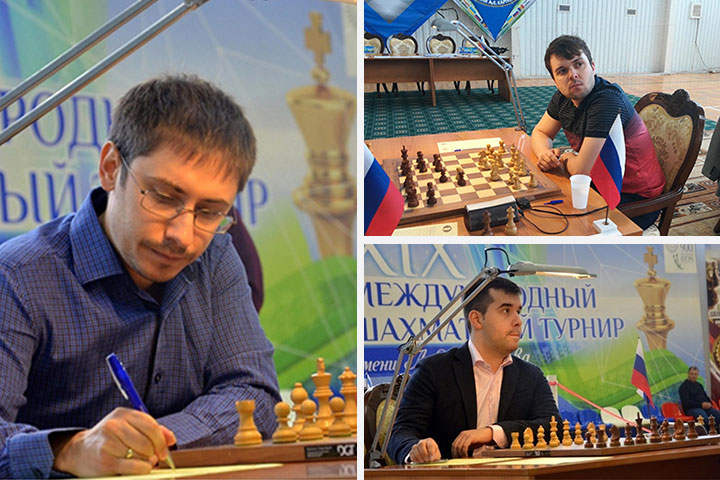Nepomniachtchi caught after nailbiting action
Past the halfway mark at the Karpov Poikovsky International, three leaders have emerged, namely, Ian Nepomniachtchi, Vladimir Fedoseev and Dmitry Jakovenko. After a convincing victory against Boris Gelfand in the opening round, Nepomniachtchi went on to win two more games against Emil Sutovsky and Anton Korobov in rounds two and four respectively, to take sole lead. But his dream run came to a crashing halt in the fifth round when he suffered a shocking defeat to compatriot Vladimir Fedoseev.
Meanwhile, in round three, Dmitry Jakovenko also put the pedal to the metal and brought home his second full point, beating Sutovsky and drawing back-to-back games against Vidit Gujrathi and Korobov to make it to the top of the leaderboard.
Round 2
The first round of this tournament was a fascinating one with all games finishing decisively. In the second round, however, things mellowed a little. But while peace was signed on most boards, top seed Nepomniachtchi seized the opportunity to race past his opposition by scoring his second consecutive win of the tournament.
'Nepo' was pitted against the tournament’s defending champion Sutovsky. The game kicked off with a French Defence which Nepomniachtchi steered into the Classical system of the opening. The position turned sharp quite early as Sutovsky grabbed white’s b2-pawn on his 9th turn. But the game was still within the realm of known theory and it was not until the 18th move that Nepomniachtchi ventured into unknown territory.
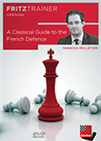 This DVD gives you the key to start out with the French Defence. GM Yannick Pelletier is a specialist of this opening, and believes that the most efficient way to understand its ideas, plans, and typical structures is to study classical lines.
This DVD gives you the key to start out with the French Defence. GM Yannick Pelletier is a specialist of this opening, and believes that the most efficient way to understand its ideas, plans, and typical structures is to study classical lines.Just two moves later, Sutovsky fumbled and allowed an elegant tactical trick that won Nepomniachtchi his opponent’s queen.
After 21.Bb6, black confidently captured 21...Rxc3 with the rook hoping that after 22.Bxd8 Bc5 will save the day. But just then Nepo struck a bolt from the blue. Can you spot what Nepomniachtchi played?
Materially speaking, Sutovsky still had enough to compensate for the loss of a queen in a rook: a bishop and a pawn. The problem, however, was that his pieces were stuck on the back rows. While Sutovsky tried to untangle himself, Nepomniachtchi had won two more pawns. By the time the first time control was reached, all tactics seemed to have fizzled out. White had two extra pawns while Black’s position was on the brink of collapse. Sutovsky threw in the towel.
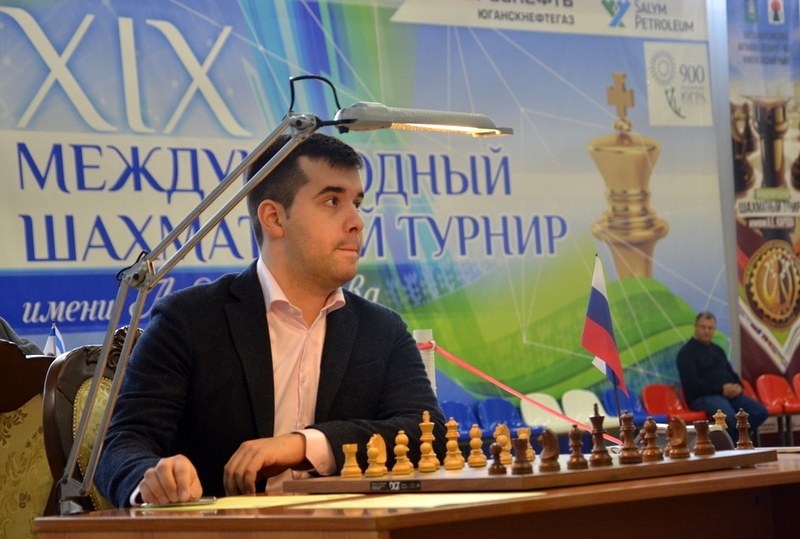
Nepomniachtchi conducted a brilliant attack in the French Defence to get the better of Emil Sutovsky | Photo: ruchess.ru
Round 3
The third round featured a faceoff between Nepomniachtchi and the third seed of the event, Vidit Gujrathi. With two wins in two rounds and an approximately 40-point rating advantage, Nepomniachtchi was clearly the favourite to win the game.
Vidit began with the non-committal 1.Nf3. Nepomniachtchi answered by moving his pawn up to d4 and soon a Queen’s Gambit position was reached. On his eighth turn, Nepomniachtchi tried unsettling his young Indian opponent by thrusting his pawn to g5, thus uncorking a novelty.
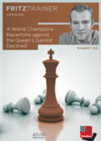 This DVD offers a complete repertoire for handling this solid opening, often featuring a dynamic approach to pose the opponent more practical problems. Both of the main continuations 3...Nf6 and 3...Be7 are covered in two separate parts.
This DVD offers a complete repertoire for handling this solid opening, often featuring a dynamic approach to pose the opponent more practical problems. Both of the main continuations 3...Nf6 and 3...Be7 are covered in two separate parts.
Vidit reacted well by stopping any further advance of the g pawn and then breaking open the kingside with h4. ‘Nepo’ answered with a pawn break in the centre and this led to complete liquidation. A draw was agreed merely 20 moves into the game.
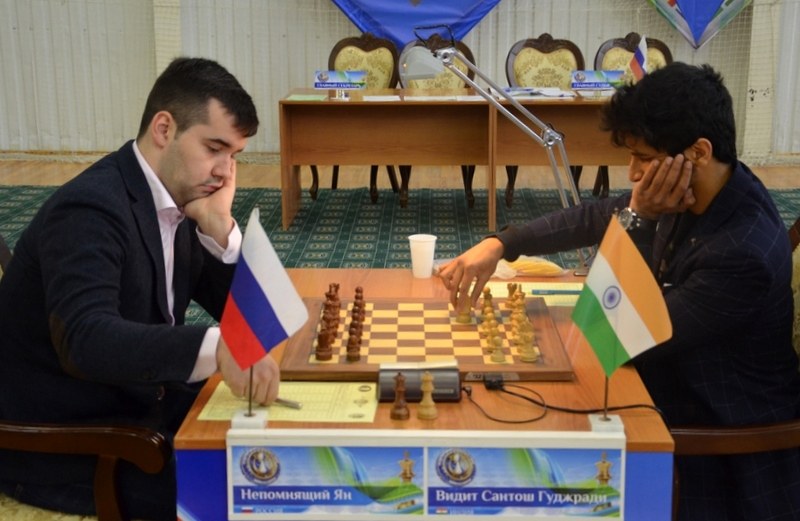
Vidit remained solid as ever against the top seed of the tournament, Ian Nepomniachtchi | Photo: ruchess.ru
At this point, Nepomniachtchi was only half a point ahead of the field. This draw, therefore, gave his chasers a chance to catch up. But only one succeeded: Dmitry Jakovenko.
Jakovenko was playing Sutovsky in this round and his game just went to show how cruel chess can be. All it took was one slip from Sutovsky and it was lights out.
In an endgame that arose from the 4.d3 Anti-Berlin, Sutovsky was up a pawn. Both sides had a queen and a rook. Jakovenko’s compensation lied in his active pieces and Sutovsky’s weak king. But with such limited material, it was hard to believe anything concrete would transpire. Yet, just then, this happened!
Sutovsky had just played 33.Rf2 here and after 33...Qe6, the threats around the white king began to become apparent.
33.Kg1 was necessary to hold the position together. After the text move, white’s position collapses like a house of cards. It still took some effort from Jakovenko but, in the end, he was able to bring home the full point and catch Nepomniachtchi in the lead.

Jakovenko joined Nepomniachtchi in the lead with this victory | Photo: ruchess.ru
Round 4
Having caught up with Nepomniachtchi, Jakovenko was to face Nepo’s previous opponent, Vidit, in round four. And yet again, with his solid play, Vidit comfortably held his Russian opponent to a draw. All it took was 24 moves.
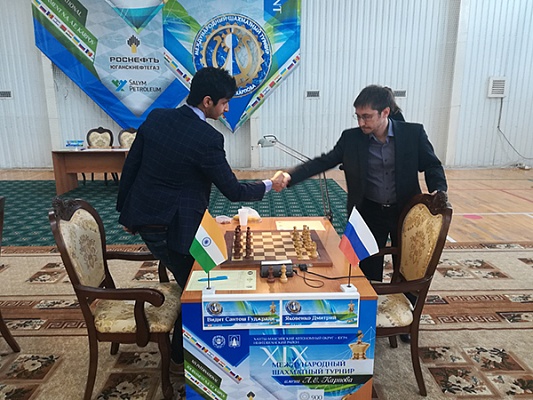
Dmiri Jakovenko and Vidit played a tepid draw in round four | Photo: ruchess.ru
But on Nepomniachtchi’s board, it was a different story altogether. A sharp Sicilian Najdorf was essayed by Anton Korobov; players castled on opposite wings and stormed towards the enemy king. But just then Nepomniachchi changed directions and began playing on the queenside. Securing an edge in the middlegame, he liquidated into an endgame where he had an extra pawn.
By the time the second time control was reached, Nepomniachtchi was already up two pawns and had caught Korobov’s king in a mating net.

Nepomniachtchi was once again the sole leader after this victory | Photo: ruchess.ru
When choosing an opening repertoire, there are days when you want to play for a win with Black, when you want to bear down on your opponent’s position with a potentially crushing attack. The Najdorf is perfect for just such occasions. Strategy, combinations, attack and defence, sacrifices and marvellous manoeuvres — exciting chess is all about the Najdorf!
Round 5
With his win against Korobov, Nepomniachtchi had reestablished himself as the sole leader of the tournament. But in round five, he was in for a shock. Playing his compatriot, Vladimir Fedoseev, Neppomniachtchi sacrificed an exchange for a pawn in a complex endgame.
Make moves in the live diagram
The computer thinks this position is equal. But to a human eye, the knight seems to be running out of squares. Fedoseev exploited this after 53…Qe7? with 54.Ra8+ Kg7 and 55.Rc8, threatening to destroy the e3 knight’s defender. Nepomniachtchi tried to hang in there with 55…f4 56.Qxf4 and 56…Nf5. But after 57.g4 hxg4 58.hxg4 Nh6 59.g5 Nf7 his misery was far from over.
The line suggested by the computer goes 53…Qg7 and after 54.Ra8+ Kh7 55.Ra4 since now if the rook goes to c8 to destroy the defender, the boot will be on the wrong foot after 55…Qd4+.
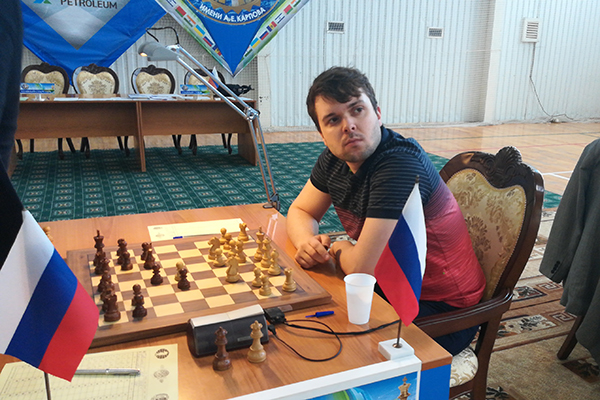
By defeating the leader, Fedoseev managed to catch Nepomniachtchi | Photo: ruchess.ru
Also, Dmitry Jakovenko, who was half-a-point behind Nepomniachtchi secured a draw against Anton Korobov to hop into the joint lead. Korobov tried very hard to carve out a win but missed his chance to win a piece on the 29th move.
Here white could win a piece after 29.f3 and after 29...Bb1 30.Rb4 Ba2 31.Rb2 Bb3 32.Qc3 Bxa4 33.Rb4 Bd1 34.Rd4 Qb3 35.Qc8+ and 36.Rxd1.
Instead, Korobov played 29.Qc8+ and had to settle for a draw after 69 moves of play.
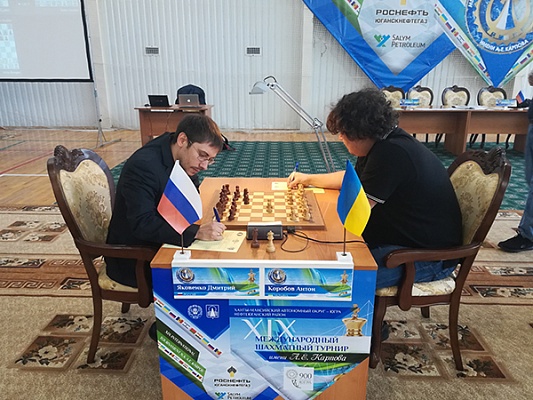
Jakovenko narrowly escaped defeat against Korobov in the fifth round | Photo: ruchess.ru
Another player who came very close to joining the leaders was Vidit, who was an exchange up against Gelfand in a complex queen and rook versus queen and bishop endgame for a very long time. And just when it seemed he had secured the win, a neat stalemate trick by the former world championship challenger secured him a draw instantly.
After 58.Kg2 (covering f1), white is just winning. Instead, Vidit went straight for the kill with 58.Re6 with the idea that after 58...Qf1 59.Qe3 Bg5 60.Qd4 (planning to win with Qh8) is crushing.
However, Gelfand had found the resource 60...g3+ here, and after 61.fxg3 hxg3 62.Kxg3, he unveiled 62...Bf4+! 63.Qxf4 Qg2+!! and the black king is stalemated after white captures the queen.
 On this DVD Alexei Shirov shows that also in the endgame, it is possible to keep struggling for the full point to the very last - if you are creative and ambitious. Because even in objectively quite balanced positions, you can frequently find ways to sharpen up or complicate the fight. For the tournament player, often all that matters is to be able to pose practical problems which his or her opponent might finally fail to solve.
On this DVD Alexei Shirov shows that also in the endgame, it is possible to keep struggling for the full point to the very last - if you are creative and ambitious. Because even in objectively quite balanced positions, you can frequently find ways to sharpen up or complicate the fight. For the tournament player, often all that matters is to be able to pose practical problems which his or her opponent might finally fail to solve.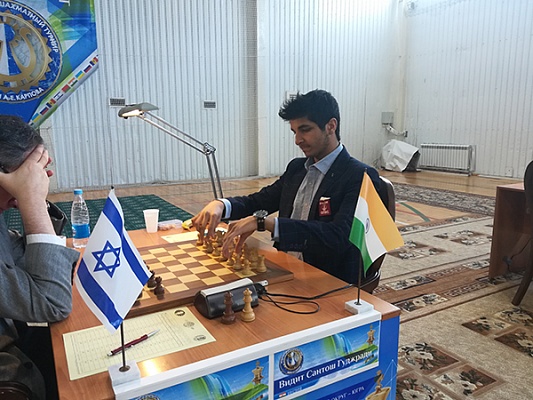
Had it not been for Gelfand's crafty trick, Vidit might be among the leaders | Photo: ruchess.ru
Four more rounds remain to be played in Poikovsky and judging by the way things have gone so far, we can expect a lot more drama in the forthcoming rounds.
All games
Links
